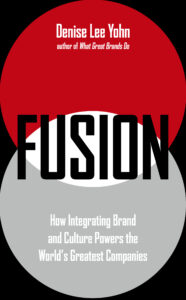Having read more books than I can name about leadership, branding, and culture, I am surprised at how rare it is to see one that combines the power of all of them.
But that’s just what my friend Denise Lee Yohn did in her exceptional new book, FUSION: How Integrating Brand and Culture Powers the World’s Great Companies.
As one of the world’s leading authorities on brand-building, Denise tackles one of the most important and overlooked aspects of a strong brand: company culture.
It’s the FUSION of brand and culture that creates organizational power.
After reading the book, which I also proudly endorsed, I followed up with Denise to talk about her research into brand and culture.
The Importance of Culture
Denise, you are well known for your work on branding. This book takes a different turn as it is as much, if not more, about organizational culture. Tell us about why you decided to address culture.
FUSION actually came out of my work with clients on strengthening and/or repositioning their brands. I found that our efforts were sometimes held back from making as much of an impact as they could have because of cultural issues inside the organization. If the culture of the organization wasn’t aligned with the brand, some leaders wouldn’t want to include culture as part of brand-building, or they didn’t appreciate the need to align and integrate their brand and culture — to create brand-culture fusion — and that prevented them from realizing the full potential of their organization and their brand.
You say that a key leadership responsibility is the integration of culture and brand. Has this always been true? What are the best ways to accomplish this?
Brand-culture fusion has always required strong leadership from the top of the organization, but it has become more important in recent years, given the corporate culture crisis that has arisen. Leaders can no longer assume their organizations will have a healthy culture if they’re nice and decent people — it takes deliberate effort to cultivate a unique, valuable, sustainable culture.
Drop Your Mission Statement
You advocate dropping the mission statement and instead focus on purpose and values. Why did you come to this conclusion? How do you recommend leaders go about discovering and sharing the overarching purpose?
Often a company will articulate a mission statement that describes what they do to create value for shareholders and other outside stakeholders and, separately, they will establish a purpose or essence for their brand. And often the two are unrelated; sometimes they are at odds with each other. With such a disconnect, your employees — and increasingly your customers who now have access to this kind of information about companies — become confused about what kind of organization you really are and what your true motivations are.
What are some ways to nurture culture? For instance, you talk about creating rituals. Would you share an example?
Culture can be cultivated in big, strategic decisions and in small, daily ones. Rituals — things your organization regularly does to commemorate or symbolize important achievements or events — may seem like small details of organizational life, but they can be used powerfully to cultivate culture. For example, at Salesforce, its culture of Ohana (Hawaiian for family) is expressed and reinforced by rituals including employees signing off their emails with “Mahalo” or the special Hawaiian-themed dinner that the company puts on for employees celebrating their 10-year anniversary of employment.
Showcase Your Culture
Showcasing your culture can also differentiate your brand. Would you share an example company doing that well?
REI, the outdoor retailer, used an aspect of its culture to differentiate its brand through its holiday season #OptOutside campaign. The campaign, which involved closing its doors on Black Friday, was conceived of as a way to reinforce its culture, which is all about the love of the outdoors. The company’s leaders decided they would pay employees to spend Black Friday outside rather than to work indoors.
They also decided to encourage customers to get out into the outdoors instead of shopping inside as well. And this turned into a movement of now over 500 organizations and companies that participate in the #OptOutside program each year. The campaign has clearly established a differentiated position for REI, not just among other retailers and sporting goods companies but also among lifestyle brands in general.
Top Leadership Errors
What are the top few leadership errors that destroy the integration of culture and brand?
The first is not taking responsibility for it. Many CEOs think that culture is exclusively the purview of the human resources department, and they delegate brand-building to the marketing department. That inevitably leads to a disconnect between culture and brand.
Your desired culture — the one that aligns with your brand identity — must be operationalized throughout every aspect of the organization, and as a leader, you must drive those efforts.
 Another mistake is thinking that there is one “right” kind of culture—a benevolent and supportive one—that works in all companies. This line of thought is not surprising since most of the existing rhetoric on culture says that managers must be warm and friendly, and they must treat their employees like family, being nurturing, encouraging, and inclusive. The fact is every organization is different, so its culture should be too. A warm and fuzzy culture might fuel one company’s growth but might backfire completely at another’s, which must be more competitive and driven by standards.
Another mistake is thinking that there is one “right” kind of culture—a benevolent and supportive one—that works in all companies. This line of thought is not surprising since most of the existing rhetoric on culture says that managers must be warm and friendly, and they must treat their employees like family, being nurturing, encouraging, and inclusive. The fact is every organization is different, so its culture should be too. A warm and fuzzy culture might fuel one company’s growth but might backfire completely at another’s, which must be more competitive and driven by standards.
For more information, see FUSION: How Integrating Brand and Culture Powers the World’s Great Companies.

